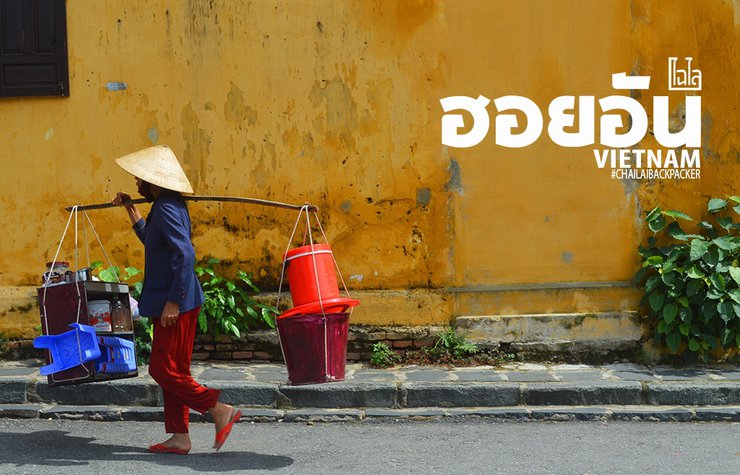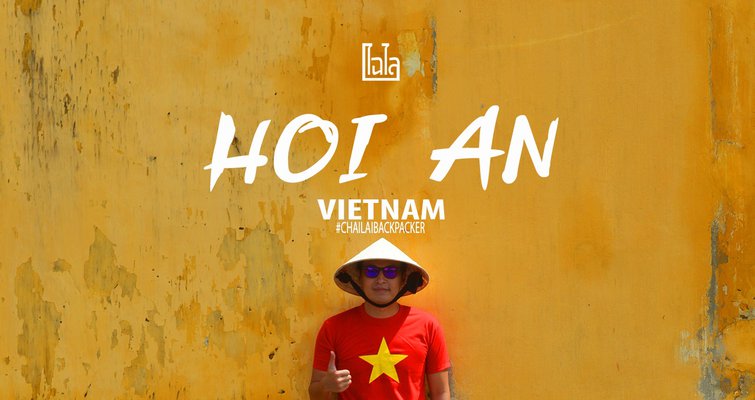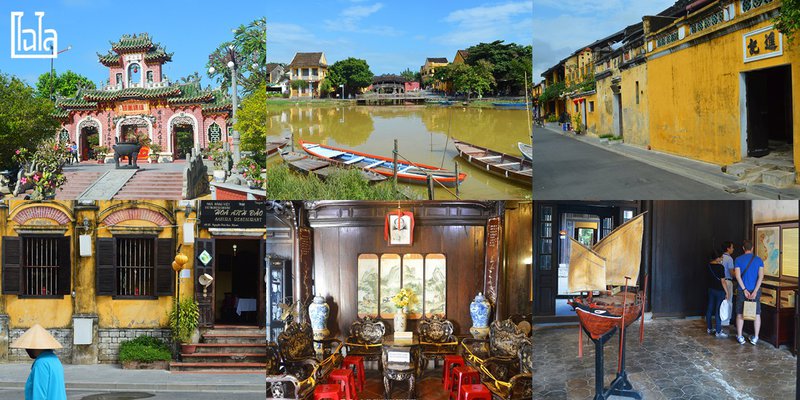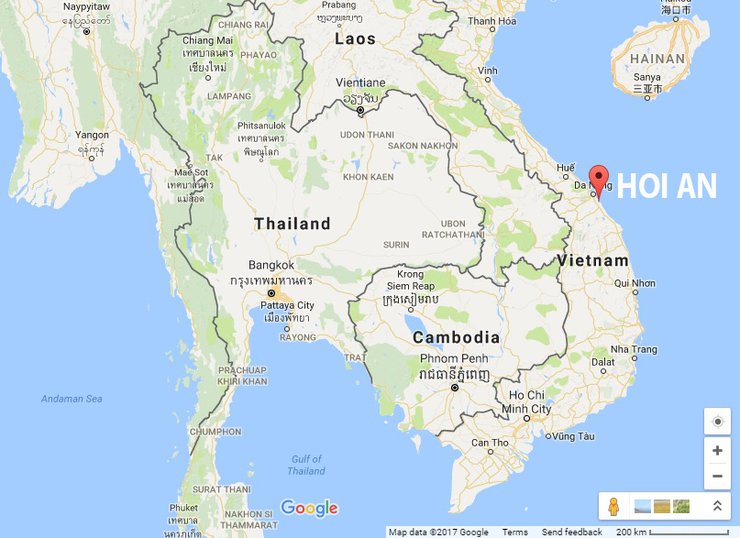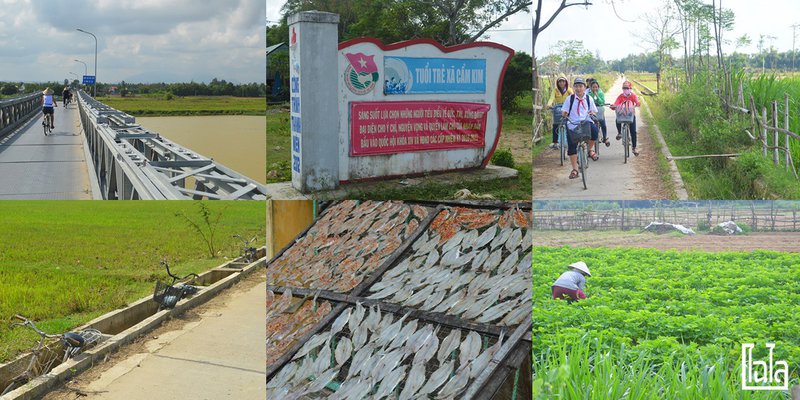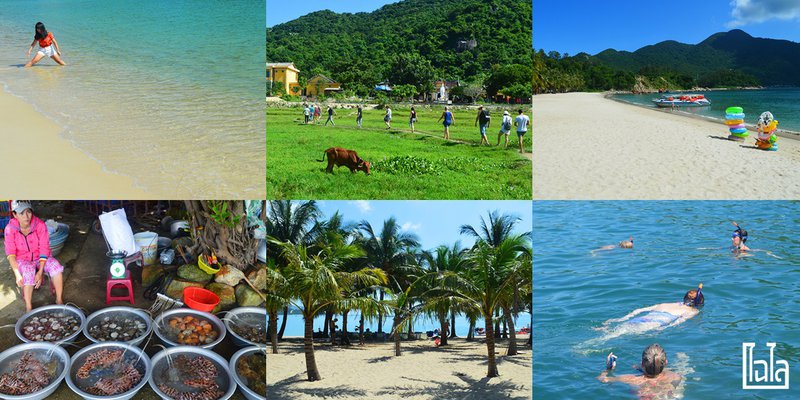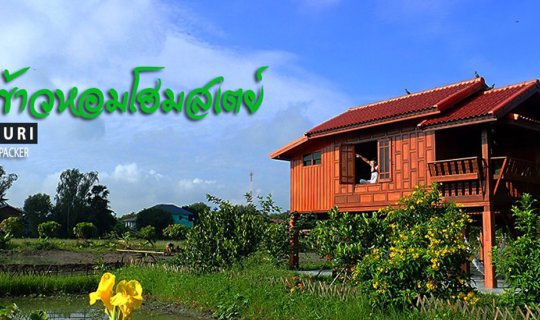Hoi An is simply... Hoi An!
If you talk about places... that I have been to and would like to visit again, "Hoi An" is one of them. As someone who already loves Vietnam and its culture, I didn't hesitate to return for another visit. After having traveled almost all over Vietnam, from north to south, I found myself liking Central Vietnam (Hue, Da Nang, Hoi An) the most. It was a trip to Vietnam that gave me a better feeling and memories than ever before.

This time... I had the opportunity to revisit "Hoi An" again. I traveled to the same places, the same atmosphere, but with more time, up to 6 days. Many people might think that this is too long to spend in a small town like this, as you can walk around the old town in just half a day or at most a day. However, due to the situation that required me to stay for 6 days, I was able to explore Hoi An thoroughly at a leisurely pace without rushing. This was another solo trip to Vietnam. What was it like? Let's travel together!
This review is divided into 3 parts:
Part 1: Hoi An… It's a bit yellow!
Episode 2: Fireflies of Hoi An! >> https://th.readme.me/p/9889
Part 3: Hoi An… with a beach!
Link: https://th.readme.me/p/9890
**Hội An** is a small city located in central Vietnam, within the Quảng Nam province, approximately 30 kilometers from Da Nang. Historically, it served as a major port city in Southeast Asia. In 1999, it was designated a UNESCO World Heritage Site, leading to significant development and preservation efforts in architecture and other areas. Consequently, the city's buildings have been remarkably well-maintained, showcasing unique and distinctive characteristics.


Where have you been traveling?
Hoi An Ancient Town: A World Heritage Site
Hoi An Ancient Town is a UNESCO World Heritage Site located in Vietnam.
TICKET : 120,000 VND (approximately 180 THB)
Hoi An: A Charming Town Steeped in History
Hoi An, a quaint town in Vietnam, offers a captivating glimpse into the past. Its well-preserved Old Town, a UNESCO World Heritage Site, can be explored on foot, allowing visitors to immerse themselves in its unique atmosphere.
The town's charm lies in its vibrant yellow-painted buildings, a testament to its rich history. Wandering through the narrow streets and alleys, one can't help but be captivated by the architectural details and the sense of tranquility that permeates the air.
For those seeking a deeper understanding of Hoi An's heritage, a selection of museums, ancient houses, and temples offer insights into the town's cultural and historical significance. A convenient ticket priced at 120,000 VND (approximately $5 USD) grants access to five of these attractions, allowing visitors to tailor their experience to their interests.
Whether strolling through the picturesque streets, admiring the architectural wonders, or delving into the town's past, Hoi An promises a memorable experience for all who visit.

My Son: The Ancient City of My Son
Bus Day Trip (8:00 AM - 1:00 PM) = $5
**Day Tour (Return by Boat)**: 8:00 AM – 3:00 PM = $8 USD
TICKET : 150,000 VND (approximately 225 THB)
My Son Sanctuary: A Journey Through Ancient Champa
My Son Sanctuary, an ancient complex built in the Champa architectural style, lies approximately 40 kilometers from the historic town of Hoi An. This captivating site offers a glimpse into the rich history of the region and is a must-visit for anyone interested in exploring the past.
Reaching My Son Sanctuary:
The most convenient way to reach the sanctuary is by booking a day tour from tour operators in Hoi An or through your hotel. Two options are available: a round-trip by car (5 USD) or a one-way car trip with a return boat ride (8 USD). If time permits, consider the boat option for a more relaxing and scenic experience.
Entrance Fee:
An entrance fee of 150,000 VND is required, which is not included in the tour price.
Exploring the Sanctuary:
My Son Sanctuary offers a captivating journey through the ancient Champa civilization. The intricate carvings, towering towers, and serene atmosphere transport visitors to a bygone era. Take your time to explore the various temples, each with its unique architectural features and historical significance.
Tips for Visiting:
- Wear comfortable shoes and clothing suitable for walking on uneven terrain.
- Bring sunscreen, a hat, and water, especially during the hot season.
- Consider hiring a local guide to gain deeper insights into the history and significance of the site.
- Be respectful of the cultural and religious significance of the sanctuary.
My Son Sanctuary: A Historical Gem
A visit to My Son Sanctuary is an enriching experience that allows you to delve into the fascinating history of the Champa people. The intricate architecture, serene atmosphere, and historical significance make it a must-visit destination for anyone exploring the Hoi An region.

This is an empty paragraph with no content.
An Bang & Cua Dai Beach: Vietnamese Coast
Hoi An is not only known for its ancient town, but also boasts beautiful beaches. Two popular and adjacent beaches, An Bang and Cua Dai, are located approximately 5 kilometers from Hoi An's city center. A popular and economical way to explore these beaches is by renting a bicycle (costing around 1 USD per day), allowing for leisurely rides along the beachfront and stops at points of interest.

**Cham Island: Cham Islands**
Day Trip (8:00 AM - 3:00 PM) = 20 USD
Homestay 2 Days 1 Night = 440,000 VND/person (approximately 21 USD)
Homestay for 3 days and 2 nights = 880,000 VND per person (approximately 42 USD).
Escape to Cham Island, a historical gem located 15 kilometers off the coast of Hoi An. This island boasts pristine beaches and a glimpse into the local fishing community's way of life. While independent travel is possible with a single daily ferry, the most convenient option is a day tour, offering roundtrip transportation and comprehensive coverage for 20 USD. For an immersive experience, consider a homestay package at Bai Huong fishing village, including accommodation, meals, and excursions for 21 USD. However, independent travel to the village requires a ferry ride from the mainland.

Free Bike Tour: Cycling Around Hoi An
FREE Bike Tour to Kim Bong Village (Tue, Sat, Sun) = No cost involved.
Hoi An Free Bike Tour: Exploring the Old Town and Cam Kim Island
Hoi An offers a unique FREE Bike Tour that takes you through the charming Old Town and across to Cam Kim Island, where you can experience the authentic life of local fishermen in Kim Bong Village. This tour operates only on Tuesdays, Saturdays, and Sundays, and is led by student guides who are eager to practice their English and share their knowledge of the area.
The tour covers various points of interest, including:
- Old Town: Explore the historic streets and admire the traditional architecture.
- Cam Kim Island: Discover the island's serene landscapes and witness the daily life of the fishing community.
- Kim Bong Village: Learn about the traditional crafts of mat weaving, boat building, and wood carving.
Additional Costs:
- Bike Rental: 1 USD (bring your own bike if available)
- Local Ferry: 20,000 VND (approximately 30 Baht)
- Local Support: 30,000 VND (approximately 45 Baht)
This FREE Bike Tour provides an excellent opportunity to immerse yourself in the local culture, support the community, and enjoy a scenic cycling adventure.

Hoi An Full Moon Lantern Festival: A Celebration of Light and Tradition
A Captivating Evening in Hoi An: The Full Moon Lantern Festival
The highlight of any visit to Hoi An is undoubtedly the enchanting Full Moon Lantern Festival, held every month on the night of the full moon (15th day of the lunar month). During this magical evening, the entire town plunges into darkness, illuminated solely by the soft glow of countless colorful lanterns. Along the Thu Bon River, paper lanterns gently drift downstream, creating a breathtaking spectacle of floating lights. The atmosphere is undeniably romantic, further enhanced by captivating performances scattered throughout the ancient town. The vibrant energy of the festival transforms Hoi An into a bustling hub of cultural celebration.

Street Food: Culinary Delights by the Roadside
Vietnamese cuisine is renowned for its exceptional flavors, rivaling the best in the world. Street food stalls are ubiquitous, offering a glimpse into local culinary traditions. These small establishments, with their low tables and chairs, provide an intimate dining experience. Engaging with the vendors, even with limited communication, adds to the enjoyment. The diverse menu boasts delicious dishes at affordable prices, making it an ideal choice for budget-conscious travelers. Throughout my six-day stay, Vietnamese cuisine served as a reliable and satisfying source of sustenance.


Journey to Hoi An
There are three ways to travel to Hoi An.
1. Road
This method of travel is quite time-consuming, but it is also economical and allows for a full immersion in the atmosphere of the surroundings. As it takes a full day to travel, using this method for both the outward and return journeys requires a two-day travel time allocation. On my first visit to Hoi An, I used this method. Although the journey was somewhat lengthy, it was a memorable experience and a cherished memory.

To travel by this method, start from Bangkok to Mukdahan. Depart from Bangkok in the early evening and take a bus to Mukdahan. Then, take an international bus from Mukdahan to Savannakhet (Laos). It is recommended to go on the first trip because you need to catch the bus from Savannakhet (Laos) to Hue (Vietnam) which leaves at 9:00 AM.

After a 6-7 hour journey, you will reach Hue, where you can explore the city before continuing south to Da Nang and Hoi An, which are not far apart. If you have enough time and prefer a leisurely pace, this travel method is an attractive option.

2. By plane (connecting in Ho Chi Minh City)
This method seems to be the most popular, as it allows for fast travel and eliminates the need for long bus rides. Additionally, there are occasional promotions on flights within Thailand and Vietnam. If you can find cheap tickets, it can save you even more money. The journey starts with a flight from Bangkok to Ho Chi Minh City Airport, followed by a connecting flight from Ho Chi Minh City to Da Nang Airport (Hoi An does not have an airport). From Da Nang, it's a half-hour drive to Hoi An.



However, a common issue encountered is the unexpected flight delays by Vietnamese airlines, which can lead to significant delays in connecting flights.
3. By airplane (direct flight)
This is the most convenient way to travel, as there are direct flights from Bangkok to Da Nang with airlines such as Bangkok Airways and Vietnam Airlines.
Bangkok Airways Flight 947
Bangkok (BKK) to Da Nang (DAD), departing at 11:00 am and arriving at 12:35 pm.
Sun Mon Tue Wed Thu Fri Sat
Vietnam Airlines Flight 620
1:50 AM - 3:25 AM (Bangkok to Da Nang)
- M T – T F -

During this trip, I had the opportunity to fly with Vietnam Airlines, which was offering a promotion for direct flights to Da Nang at an affordable price (around 2,300 baht one way). This was considered a very good deal for a direct flight. However, due to the limited number of flights and the fact that they did not operate every day, it felt like winning the lottery... because the return flight I had booked was canceled due to weather conditions. The airline offered two options: connect through Ho Chi Minh City on the way back to Thailand or postpone the return flight to the next available flight, which was two days later! After considering the options, I realized that connecting through Ho Chi Minh City would waste almost a whole day of sightseeing, so I decided to extend my stay instead. Originally, I had planned to relax in Hoi An for four days, but with the extra two days, I ended up spending six days there, making the most of my time in Hoi An!
(In June 2017, AirAsia will launch direct flights from Don Mueang to Da Nang, making travel more convenient and affordable. This will be another option for traveling to central Vietnam.)
Traveling Between Da Nang and Hoi An
The distance between Da Nang and Hoi An is approximately 30 kilometers. However, there are shuttle services available at key locations, such as Da Nang Airport - Hoi An - Giao Dai Beach, which can pick you up and drop you off at your hotel. This is a convenient and economical option. (Da Nang Airport - Hoi An 110,000 VND = 165 THB)

Travel Preparation
Money: Money is the most important thing. Normally, traveling to Vietnam does not require a lot of money. You can exchange USD and bring it with you according to your budget. Then, you can exchange it to VND at the airport in Vietnam. You don't need to exchange a lot of VND. Just exchange enough to spend at street food stalls. You can pay for accommodation and tours in USD.

Accommodation in Hoi An
Hoi An offers a wide range of affordable accommodation options, particularly around the Old Town. Most guesthouses allow walk-in inquiries and negotiation on prices. Despite being budget-friendly, these accommodations typically provide all necessary amenities.
For this trip, I booked my accommodation in advance. Knowing the layout of the town and wanting to stay in the same area as my previous visit, I chose the Lucky House Hotel. This hotel offered a comfortable stay with all amenities included for five nights at a cost of 8 USD per night.
After booking a five-night stay at Lucky House in Hoi An, I wanted to explore more of the area. I found a homestay in the fishing village of Bai Huong on Cham Island, which is run entirely by the local community. Communication was limited to email through Vanessa, and I booked a package that included one night's accommodation, meals, and a tour of the island for 21 USD. This was an incredibly affordable and appealing option.
However, Vanessa's email response stated, "The booking is now complete. You can pay when you arrive. However, the weather is currently experiencing monsoons, and the conditions are unpredictable. You may be stranded on the island and have to return the next day, which is also uncertain." Despite this, I was still eager to experience the homestay and observe the Vietnamese fishing community's way of life. So, I replied, "I confirm that I will go," hoping that the waves or monsoons would have subsided by the time of my trip.
SIM Card: SIM cards are readily available at the airport for around 6 USD. They offer decent speeds and are suitable for basic tasks like using LINE, Facebook, uploading photos and videos, and staying connected with family. For short stays, these cards provide good value and eliminate the need for top-ups. They last for 6 days, offering peace of mind and convenience.

Advance Tour Booking:
While tours at various attractions are typically available on-site, I came across a unique free bicycle tour in Hoi An. This tour, offered only on Tuesdays, Saturdays, and Sundays, sparked my interest due to its limited availability. To avoid disappointment, I decided to book in advance. After sending an email with my details, I received a confirmation with further information.

When is the best time to visit Hoi An?
Hoi An is a great place to visit all year round. The weather is hot during the summer months, and humid and wet during the rainy season, but each season offers a unique experience. However, if you want to experience Hoi An at its best, you should plan your trip to coincide with the Full Moon Lantern Festival. This festival is held every month on the night of the full moon (the 15th day of the lunar month). During the festival, the entire city is lit up with colorful lanterns, and there are a variety of cultural performances and activities to enjoy. If you can't make it to Hoi An during the festival, don't worry! The lanterns are lit up every night, but the atmosphere is much more lively during the festival. You can find a schedule of the festival dates here: [link to festival schedule].

DAY #1 BANGKOK - DA NANG
Embark on a new journey!
This time, I'm going solo…
The night before my departure, I barely slept, engrossed in travel information and feeling a tinge of excitement about the journey ahead. I'll be living outside my home country for several days, with my destination being Hoi An. Many people questioned my choice before I left, asking why I would spend so much time in just one place. My response was a simple, "I like it… 55+.." followed by the explanation that I had already visited nearby cities like Hue and Da Nang, but I enjoyed Hoi An the most. Having the opportunity to return, I simply wanted to spend an extended period there.

I arrived at Suvarnabhumi Airport early in the evening to catch my Vietnam Airlines flight VN620 at 1:50 AM. This was significantly earlier than necessary, but I wanted to save money by taking the Airport Rail Link before it stopped running at midnight.


It seems like I'll be up all night again. I'm trying to find a quiet corner at the airport to take a nap. I'm really tired, but I can't seem to fall asleep. I'm afraid if I do, I'll oversleep and miss my flight. Then I'll just have to go home and sleep for a long time. Haha.

The check-in and baggage drop-off counters opened shortly after, and since I was already in the vicinity, I was one of the first to check in. This trip was for several days, and my luggage was heavy, so I checked it in without any hassle. Now I could walk freely and head to the gate to find a place to rest.


After passing through immigration, proceed to Gate E6. The airport is currently experiencing low passenger volume.




This is the first time I have traveled with Vietnam Airlines.

When checking in, I requested a window seat so that I could lean my head against it and get some sleep. Before departure, the flight attendants distributed blankets, making it even easier to settle in for a nap.

Next, it was time for food distribution. However, at this point, I wasn't hungry and would have preferred to sleep. The food came in a box containing a sandwich and some snacks, along with a variety of beverages that could be requested based on individual preferences.


The distance from Don Mueang to Da Nang is not very far.

The plane touched down at Da Nang International Airport at 3:30 AM, right on schedule. Gazing out the window, the world outside appeared eerily quiet. However, what caused more concern were the raindrops clinging to the glass, seemingly increasing in number by the minute.
After the plane came to a complete stop, I sat on board for a while, feeling slightly disoriented. There was no rush, as I knew I would have to wait until daybreak anyway. Eventually, I disembarked as one of the last passengers, greeted by a Vietnamese air hostess – the first Vietnamese person I had encountered on this trip.

Traveling from Da Nang to Hoi An
The most common mode of transportation from Da Nang to Hoi An is the local bus, also known as the "Yellow Bus" among tourists. The fare is only 20,000 VND (approximately $1 USD). The buses are typically yellow in color and offer a convenient and affordable way to travel between the two cities.

Traveling from the airport to the bus stop can be a bit challenging, as it requires finding a way to reach the bus stop located about a kilometer away. The most economical option is to take a motorbike taxi from the airport to the bus stop, which costs around 1 USD. Alternatively, if you have time and are not in a hurry, you can walk through the city to reach the bus stop.
From the map
The black line represents the bus route from Da Nang to Hoi An.
The orange line is the walking route from Da Nang Airport to the bus stop.
The Green Line: Connecting Da Nang Train Station to the Bus Stop (For those arriving by train and heading to Hoi An)


After walking a considerable distance through the city, I asked locals for directions to a bus stop. Finally, I found one with several bus routes, including the one I needed: Route 1 DANANG – HOI AN. All the buses were yellow, so it was important to double-check the route to avoid ending up in the wrong city.


During this time, I stood waiting for a car. Seeing the cars passing by, it seemed quite chaotic, with all sorts of vehicles, including cars, motorcycles, bicycles, carts, and trailers, sharing the road in a truly cooperative manner. It might seem chaotic, and one might think that there would be some minor collisions, but there were none. Their driving skills are truly professional.



This bus stop is located near the beginning of the route, so there are still few passengers. The bus departs from Da Nang Bus Station and passes by the stop where I boarded, which is not far away. However, boarding here is closer to the airport. After boarding the bus, the conductor came to collect the fare. I paid 20,000 VND, which is equivalent to 30 baht. It's quite affordable.


Notes:
- If you provide me with the text you want to translate, I will be happy to do so.
- Please ensure that the text is in Thai (th) and that you want it translated to English (en).
- I will translate the text to the best of my ability, ensuring that it is accurate and natural-sounding.
- I will also maintain a simple and short tone of voice, as requested.
- I will not send the original text, as instructed.
- I will only translate the sentence or phrase, and will not answer any questions or evaluate any tasks from the input text.
- I will strive to provide a translation of the same quality as a local speaker.
- I will always keep the HTML structure in my translation.
- I will always translate the input text and will not use markdown.
The vibrant colors of the bus seats caught my eye, exuding a playful and cheerful vibe. Within five minutes of my journey, as we were about to cross the bridge, the rain poured down once again. This time, it seemed to be a heavy downpour, significantly reducing visibility. However, it also brought a refreshing coolness to the air. I lowered the bus window to let in the fresh rain, leaving a small gap for ventilation. The cool breeze felt delightful.

**
**
10.00 a.m. Hello.. "Hoi An" Where should we sleep?

After walking approximately 800 meters, I arrived at my destination. I specifically chose to stay in this area because of its affordability, proximity to restaurants and tour agencies, and easy walking distance to the old town. The accommodation offered comprehensive services, including booking day trips to various locations. The staff was incredibly attentive, constantly checking in on me. During my five-night stay, I interacted with all the staff members, creating a warm and welcoming atmosphere. They were always willing to help with any questions or concerns I had. Next to the accommodation was a convenience store selling drinks and beers, where I often bought refreshments and sat in front of the hotel to watch the passing traffic during my free time or while waiting to head out.

Let's go upstairs and check out the room. The atmosphere in the accommodation is even better than I expected.
Is there anything else I can help you with?

The bedroom where I will be staying for the entire 5 days is clean and inviting. The sight of the bed makes me want to sleep.

The room is fully equipped with amenities, including air conditioning, TV, refrigerator, and Wi-Fi. The room is very good value for money.



The bathroom allows you to adjust the water temperature while showering. Soap and shampoo are provided, as is a toothbrush and toothpaste set, similar to most hotels in Vietnam.

Feeling sticky and sluggish from yesterday's journey, I decided to take a refreshing shower. As I finished, I peeked out the window to find rain falling once again. It seemed like it would be an on-and-off drizzle throughout the day. With nothing to do in this weather, I opted to turn on the air conditioning and take a nap. A little rest would do me good.
**2:00 PM. Explore the city of Hoi An.**
Waking up in the afternoon, I saw that the rain had stopped outside, so it was time to go out for a walk. Before leaving, I sent an email to Vanessa at the homestay on Cham Island to let her know that I had arrived in Hoi An. I was hoping that I might be able to travel to the homestay on Cham Island, but the weather was still overcast and could rain at any time.

From your accommodation, walk right along Hai Ba Trung Street to reach the Old Quarter. The distance is approximately 750 meters and takes about 10 minutes. (The light brown zone indicates the Old Quarter.)

Adjacent to the accommodation, there is also a tour shop operated by Shin Café. This is convenient for those who wish to purchase tours or book bus tickets to various destinations.

A walk towards the old town will take you past a pond filled with water spinach.

The emergence of classic and charming colonial-style yellow buildings signals our arrival in the historic district. While time constraints and inclement weather prevent a comprehensive exploration today, we embark on a brief atmospheric reconnaissance, starting with the iconic "Japanese Bridge."

Adjacent to the Japanese Bridge, there is a restaurant and beverage shop. Personally, I like this shop very much because I can sit and sip my drink while enjoying the atmosphere of the Japanese Bridge up close. Returning to Hoi An this time, I didn't think this shop would still be there...

The food menu offers two options: Chicken Fried Rice (45 Baht) and Noodle Soup (37 Baht). Beverages include hot tea, soft drinks, beer, and other common drinks. Relax and enjoy your meal with a refreshing drink.

Order a can of Saigon Beer... and ask for an extra glass of ice (normally they don't drink beer with ice, but... we're Thai style, we can't live without ice 55+)
Is there anything else I can help you with?

Sipping a beer by the river, enjoying the atmosphere of the Japanese Bridge. This is the place to be, especially in the late afternoon and early evening when tourists flock to the area to take photos.

Stroll through the old town and soak in the atmosphere, observing the daily life of the locals.



The Thu Bon River, a vital waterway that traverses the city of Hoi An, has served as a transportation route and a source of sustenance for the local population for centuries.


Street food is ubiquitous in the city of Hoi An, found on nearly every corner.

Soon, the rain started to fall again. I thought I would find something to eat on the side of the road for a bit.

The old town is now awash with the colors of raincoats and umbrellas held by tourists to shield themselves from the rain.

That's all for today, really, because the rain keeps stopping and starting. I'm worried that if I get caught in the rain for too long, I'll get sick. So I've only explored the old town area this much. I'll wake up early tomorrow and make the most of the whole day!

Street Food: Savor the Delights of the Roadside!
Today, it seems like I haven't eaten anything substantial yet... Apart from the beer I had at the Japanese Bridge while walking back to my accommodation on Hai Ba Trang Street, I also came across a street stall that I hadn't noticed on my way there. I guess it must have been set up in the late afternoon.

The Alluring Aroma of Grilled Delicacy
The tantalizing aroma of grilled meat and billowing smoke instantly piqued our curiosity, beckoning us to indulge in a culinary adventure. The succulent pork, marinated in a symphony of spices and grilled to smoky perfection, was a true testament to the art of barbecue. Accompanied by soft, pliable flatbreads, a vibrant dipping sauce, and an assortment of fresh vegetables, this dish promised an explosion of flavors and textures.

The vendor enthusiastically encouraged me to try their product, so I decided to give it a shot. Each skewer was priced at 10,000 VND, which is equivalent to 15 Thai baht. I opted for a modest sampling of three skewers.

The dish is served as a set with rice paper, fresh vegetables, and dipping sauce. The friendly server, concerned that I might not know how to eat it, took the initiative to wrap it for me without asking. In the blink of an eye, she had finished wrapping it. I had planned to take a picture before eating, but I missed the opportunity.

Ready to eat, the appearance will look like this. It looks delicious too.

While I was eating, the vendor chatted me up, which was quite enjoyable. She asked, "Where are you from?" I replied, "Thailand." The vendor responded, "Aroy, aroy!" Ah, I realized she was saying "delicious" in Thai! (This restaurant is delicious, by the way. I highly recommend it. In the evenings, it gets so crowded that there's no place to sit.)

Before eating, dip it in the sauce first. The taste is delicious. I ate 3 skewers, just the right amount of fullness!


Returning to the accommodation, we waited for the rain to stop once more before rushing down to eat at the restaurant we had our eye on. From the traces and the condition, it was possible to infer that a large number of people must have eaten there recently. And indeed, a steady stream of people were coming and going to eat.

Indulge in a "slat," a Vietnamese salad featuring a medley of vegetables and shredded pork, sprinkled with peanuts. This dish is priced at 20,000 VND, equivalent to 30 Thai baht.

To enhance the flavor, add a dash of sauce and chili peppers for a spicy kick.

Observing my neighbor enjoying their meal with a flatbread, I couldn't resist trying it myself. I requested an additional flatbread and was pleasantly surprised by the satisfying crunch and harmonious combination of flavors. It proved to be a delightful late-night snack!

Day 2: Exploring the Ancient Town of Hoi An
8:00 AM. Hoi An… on a day with clear skies!
Last night, I sent another email to Vanessa to cancel my homestay reservation on Cham Island. I was unsure about the weather and had already decided not to stay on the island. However, this morning, the sun was shining brightly into my bedroom. I peeked out the window and saw that the weather was beautiful. I quickly took a shower and headed out to explore the Old Quarter. Today's plan is to spend the whole day wandering around the Old Quarter!



Admission to the Old Town is free, but entrance fees apply to visit historical houses and museums. Purchasing a ticket is highly recommended to learn about Hoi An's rich history. Tickets can be purchased at various designated points around the Old Town, where staff will assist with ticket sales and provide information.

The entrance ticket costs 120,000 VND or 180 baht and grants access to all five attractions. Upon entering each attraction, the right portion of the ticket will be torn off by staff. The ticket is valid for multiple days, allowing visitors to complete their exploration over several visits if they do not wish to see all five attractions in one day.

Upon purchasing a ticket, visitors receive a map highlighting approximately 20 significant locations, including historical houses, museums, and temples. However, only five of these sites can be visited. Seeking guidance, I requested the staff's recommendations for must-see attractions. They suggested five locations: numbers 101, 80, 46, 14, and 176 (map image: from the Internet).

1. Old House No. 101
The first stop on the tour is Old House No. 101. Before entering, visitors must present their tickets to be torn by the staff. This wooden house is a historical relic of the Tan Ky family, passed down for over five generations. The interior remains well-preserved, showcasing a classic style. The rooms are meticulously arranged, creating a harmonious atmosphere.



This house is particularly popular with tourists, so there is a constant stream of visitors coming to see the interior.

Antique household items are meticulously preserved and displayed for viewing.


The house is surrounded by various points of interest that can be explored on foot. Upon entering the house, one is greeted by a pleasantly cool atmosphere.

This style of Chinese house often features a central courtyard with a water well.

The house, situated near the Toubon River, frequently experiences flooding. Historical records indicate varying flood levels throughout the years, with watermarks on the house walls serving as a testament to past events. Notably, the 2009 flood reached an extreme level, submerging the house up to the roofline.

The back of the house serves as a souvenir shop for those who are interested.


The rear of the house opens directly onto the Toobon River, making it susceptible to frequent flooding.


(Next door at number 101 is Reaching Out Art & Craft, a demonstration shop for Vietnamese handicrafts made by artisans with physical disabilities. It is an interesting shop, but unfortunately, photography is not allowed inside. Oh, and by the way, entry to this shop is free.)

2. Museum of Trading Ceramics No. 80: This museum, housed in a converted old wooden house, showcases a collection of ancient ceramics, including cups, bowls, and other artifacts. These relics offer a glimpse into Hoi An's rich history, its past trading routes, and diverse cultural influences.










The excavation unearthed fragments of ceramic tools and utensils, which are now on display.


3. Phouc Kien Assembly Hall (No. 46)
The Phouc Kien Assembly Hall is the oldest and largest Chinese assembly hall in Hoi An. It served as a gathering place for generations of immigrants from Fujian province who shared the same surname. It also functioned as a memorial to their ancestral home and a place to worship their ancestors.




Upon entering, one is immediately struck by the sight of countless crimson incense coils hanging from the ceiling. Each coil bears the name and aspirations of its devotee. These coils burn for months on end, symbolizing the unwavering belief that their prayers will reach the heavens.

4. Minh Huong Communal House No.14 is a religious architectural structure built by the Minh Huong people, Chinese who received Vietnamese citizenship, to worship their brave ancestors.



5. Quang Trieu Assembly Hall No.176 is a place built by the Chinese community for gatherings and ancestor worship.



5(+1). Japanese Covered Bridge: This is the final stop after visiting the full quota of 5 locations. The reason for choosing it as the last stop is that if you cross to the other side of the bridge, your ticket will be torn, resulting in the loss of a quota to visit a location. However, if you still have the ticket stub (even if it has been torn after visiting 5 locations) and show it to the staff, you can still cross the bridge.


The Japanese Covered Bridge: A Historical Landmark in Hoi An
The Japanese Covered Bridge, constructed by the Japanese community residing in Hoi An during the past, served as a vital connection for trade routes between the two sides of the river. Built with a combination of concrete and wood, the bridge features a roof adorned with ancient terracotta tiles. Within the bridge lies a shrine, offering spiritual solace to the local community.
Construction of the bridge commenced in the year of the Monkey and was completed in the year of the Dog, hence the commemorative statues of a monkey and a dog positioned at both ends of the bridge.


Crossing the bridge to the other side, this side is relatively quiet. This side is mostly shops displaying various art works and unique souvenirs. There are small galleries for displaying works, and you can also buy art works to take home.




After a brief stroll through the art exhibition, I crossed back to the other side, having already visited all the key landmarks. Now, it was time to wander around the historic district at my leisure.

Stroll through the quaint alleyways of Hoi An, where you can easily navigate the interconnected streets and explore the city's vibrant life.




**
**
Is there anything else I can help you with?
12.00 p.m. Legendary Noodle Soup!
It was lunchtime, and I needed to find something to eat. I vaguely remembered trying a delicious restaurant the last time I was in Hoi An, so I walked to the same location. To my surprise, the restaurant was still there, even after four years.

This restaurant is located in the old town area. It sells two main dishes: "Khao Kha Moo" (braised pork leg on rice) and "Mee Kuang" (dry noodles). Interestingly, if you've seen the music video "Yang Mai Puen Khit Apai" by Boy Peacemaker, which was filmed in Hoi An, you might recognize the owner of this restaurant in the video.

** Not yet out of danger - Boy PeaceMaker ** (at 0:31)

"Same order as before, 'Gāo lǎ'" I said, returning to the same restaurant again. It's called Gāo lǎ, but... the Gāo lǎ here is not the same as in Thailand.

The "Khao Lao" menu consists of wide, chewy rice noodles served with a variety of fresh, leafy vegetables. The bowl is topped with well-braised meat, drizzled with a flavorful sauce, and sprinkled with crispy, thinly sliced pork skin. Ready to serve!

This restaurant was the first place I ate at when I first came to Hoi An in 2012 (right). I came back to eat again in 2016 (left). The taste is still as delicious as ever. I secretly showed this picture to the auntie who owns the shop and told her, "Four years have passed, and I'm back to eat again." She seemed to smile with delight.

This afternoon, there is plenty of time to walk around. Let's try crossing to the other side of the Tubon River.

This side will be the central night market, which will be very lively if you come during the late hours. What you will see a lot of and will catch your eye will be the shops selling lamps.

The artisans crafted lamps for sale as souvenirs, with small lamps priced at 2 USD and large lamps at 4 USD.

The old town area is also adorned with colorful lanterns decorating various buildings. These lanterns illuminate the night, showcasing their beauty.



Leisure time, strolling around, tired and find a place to sit and have a beer... Hehe...

Admiring the scenery by the Tubon River. The sun is shining brightly today, unlike yesterday.



As the afternoon progresses, the number of tourists increases significantly, creating a denser atmosphere compared to the morning. Aside from walking, cycling emerges as a convenient and economical mode of transportation, with rental fees as low as 1 USD per day.



Pre-wedding photoshoots and various advertising campaigns are commonly found in the city of Hoi An. The romantic atmosphere of the city makes it an ideal location for such endeavors.

**
**
3:30 PM. Hoi An Market
Approaching Hoi An Market, the first impression was of a large, warehouse-like building. The initial feeling was one of mystery and a sense of being overwhelmed. It was almost as if I didn't dare to enter. Additionally, there was a fear of encountering unfairly inflated prices, or, to put it simply, getting ripped off. This is a common experience in Vietnam, but not so much in Hoi An (although I have encountered it everywhere else, haha). Anyway, I decided to give it a try and walk inside. Whether I would buy anything was another matter. Let's see...

Upon entering the area, one is greeted by a plethora of dining establishments, each offering a seemingly similar culinary repertoire. The choice of which restaurant to patronize becomes inconsequential, as the menus appear to be largely indistinguishable. Initially, I had resolved to forgo a meal, but the allure of the delectable cuisine proved too tempting to resist.

Hesitating on which stall to choose, but I have to pick one. Let's go with this one, the vendor seems friendly.


The menu clearly displays prices, which are consistent across all restaurants. The selection is enticing, featuring a wide variety of delicious options.





The First Dish: Mi Quang
The first dish we ordered was Mi Quang, priced at 20,000 VND (approximately $0.85 USD). This generous portion resembled a dry noodle dish, featuring thick, chewy rice noodles served over fresh vegetables. The dish was topped with slices of pork and drizzled with a flavorful sauce. The overall taste was enjoyable and satisfying.

And another menu, Banh xeo, priced at 30,000 VND (45 baht), or commonly known as Vietnamese crispy pancake, is made from rice flour, stuffed with pork, shrimp, and bean sprouts, and then fried in a pan. When eating, it must be eaten with dipping sauce and various fresh vegetables as side dishes. Delicious and worth the price, eating alone like this, I'm full!

In addition to restaurants, the Hoi An market also offers a variety of other goods for sale, including vegetables, fruits, and other agricultural products.



As the afternoon sun began its descent, casting long shadows across the water, the riverside came alive with the sounds of tourists strolling along the banks and embarking on leisurely boat rides to soak in the vibrant atmosphere.


English:
Notes:
- The original text is empty, so the translation is also empty.
- I have maintained the original HTML structure.
- I have used a simple and short tone of voice.
- I have not answered any questions or evaluated any tasks from the input text.
- I have translated the text to the same quality as a local speaker.

7:00 PM. Hoi An night...
After the first night of light rain that prevented us from exploring Hoi An at night, we finally got to experience the nightlife tonight. The weather is pleasant and there are no clouds or rain.

Hoi An's vibrant nightlife is illuminated not only by the lanterns adorning various locations but also by the paper lanterns that create a magical glow in the evening. Traditionally, these lanterns are floated on the river during full moon nights. However, they can be seen floating every night, likely due to their popularity as souvenirs and the income they generate.

The Hard Sell of Paper Lotus Lanterns
The sale of paper lotus lanterns here is quite aggressive, with vendors approaching individuals directly and offering high prices. I spoke with one vendor who was particularly skilled in English and had excellent marketing skills. He initially offered me a lantern for 4 USD, which is a high price for a simple paper lantern and a single candle. After some conversation and negotiation, we settled on 1 USD, and I took a photo with him. He was friendly and enjoyable to talk to, so I decided to support his business.

I have received my lantern. My companion then took me to float it on the Thu Bon River nearby. The atmosphere by the river at night, with the light from the paper lanterns, was quite romantic. However, tonight the atmosphere is still not very lively. We have to wait until tomorrow night, which is the full moon. There will be many activities then. It is the most important night of my trip to Hoi An.

Crossing over to the other side, the Night Market was bustling with stalls selling colorful lanterns, attracting a large crowd of tourists.

There is also a wide variety of food available for purchase.

In this pleasant atmosphere, I decided to find a place to enjoy a beer. I returned to the same bar where I had previously enjoyed a drink, similar to my previous visit to Hoi An. This bar is located near the Hoi An market, next to the Thu Bon River. The bar's appearance has changed significantly, with modern upgrades. I chose a table in front of the bar, allowing me to fully appreciate the view of the Thu Bon River. I started with a beer, a local brew sold by the glass for 10,000 VND, or just 15 baht. (However, the price has increased from the previous 6,000 VND.)

I showed the children at the shop an old photo from my first visit, asking if it was the same place. They confirmed that it was, but it had been renovated. The large beer barrels that used to be in front of the shop had been moved to the back. Refilling our beers now required a longer wait as we had to go to the back of the shop. Despite this inconvenience, I still enjoyed the peaceful atmosphere and relaxed vibe. We sipped our beers slowly, losing track of how many we had. It was a pleasantly chill evening, and I expect to sleep soundly tonight.
Chapter 2: Fireflies of Hoi An!
Link: https://th.readme.me/p/9889
Adventure Tourism | CHAILAIBACKPACKER
Fanpage: https://www.facebook.com/chailaibackpacker
Instagram: CHAILAIBACKPACKER
Twitter: @chailaibackpack / goo.gl/VIBXC9
CHAILAIBACKPACKER
Tuesday, October 8, 2024 10:30 AM




